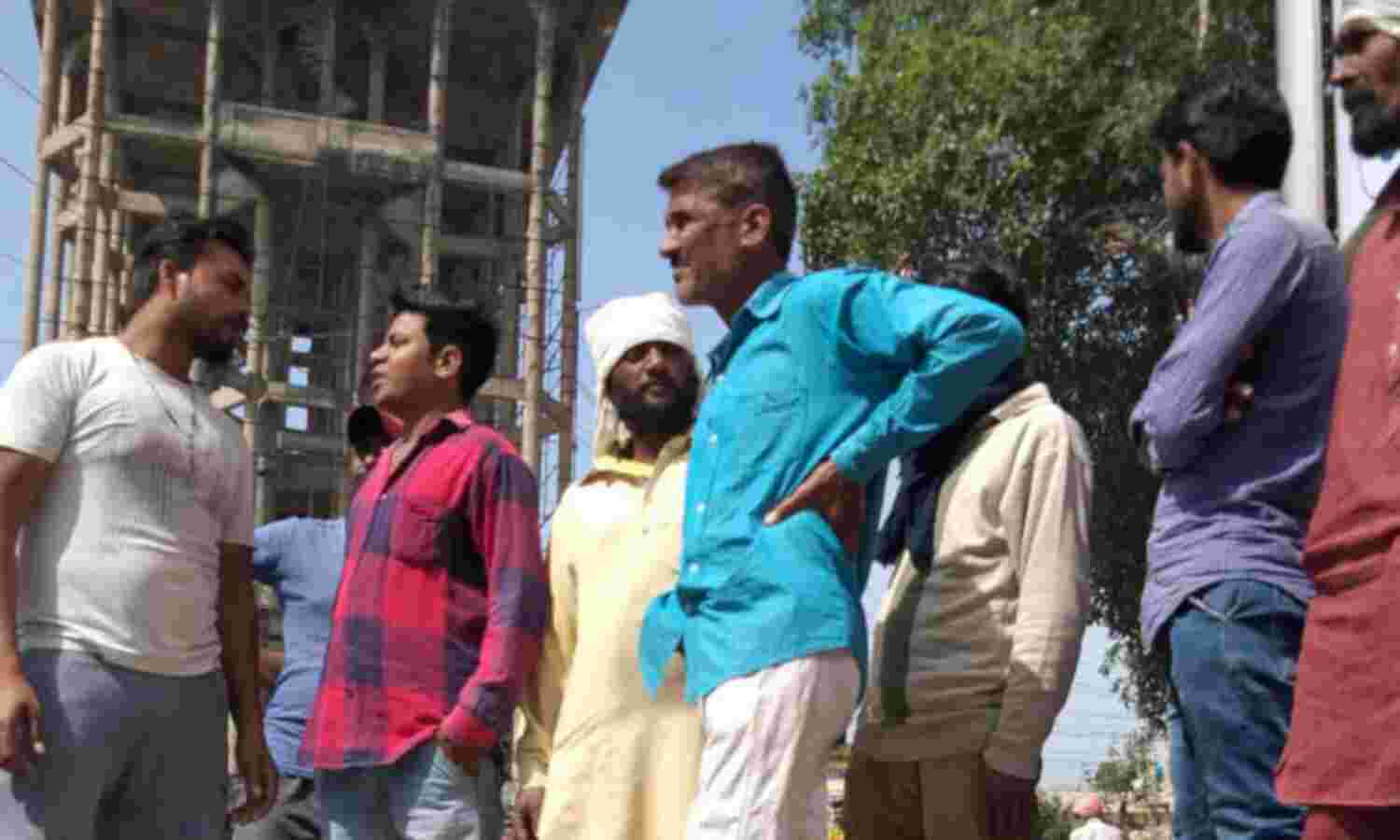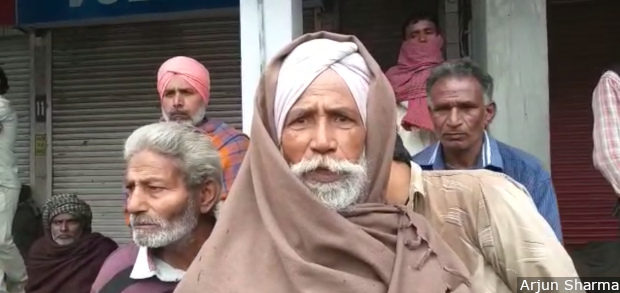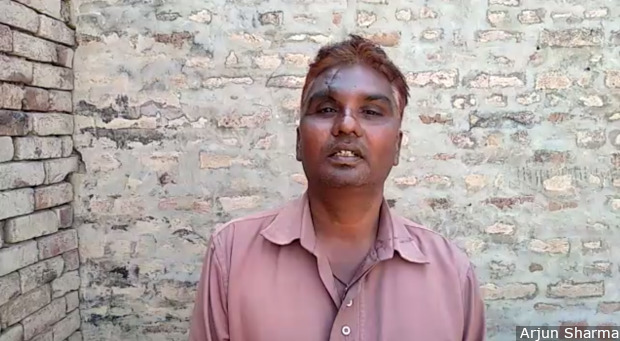In Punjab’s Labour Hubs, Workers Plead For Jobs At 1/3rd Wages

Bathinda: Stress had put deep wrinkles on Balkara Singh’s forehead though he was just 32 years old. The daily wage worker, dressed in a faded blue sweater and jeans, has come to the Gol Diggi labour hub in southern Punjab’s Bathinda city every single day for the last five years to look for jobs.
Since the end of 2016, he has returned home disappointed most days. The best he could hope for were about 10 days of work in a month, he said.
Poverty drove Balkara out of school when he was in Class 2 and his only dream was to see his children--aged four and six--complete their education. His small house in Amargarh village where he lives with his wife, children and parents, is about 14 km from Gol Diggi. It takes two bus changes and Rs 30 to reach the hub.
When we met Balkara in early April 2019, he was no longer sure if his dream would ever come true. The move by the Narendra Modi government in November 2016 to withdraw 86% of India’s currency, by value, had knocked the bottom out of the casual jobs sector which ran on cash payments--agriculture, small scale textile units, unorganised retail businesses, and tourism as IndiaSpend has reported.
Five million men, mostly from the unorganised sector, lost their jobs over the two years following demonetisation, said a new report ‘State of Working India 2019’. This latest estimate of job losses was published by the Centre for Sustainable Employment (CSE), Azim Premji University, Bengaluru, and released on April 16, 2019. The numbers would have spiralled if women were to be included in the study.
As Punjab votes on May 19 in the ongoing general elections to the Lok Sabha, we look into the state’s informal jobs crisis.
The unemployment rate in Punjab in November 2016--when demonetisation was announced--was 4.9%, which increased to 6.1% in December 2016 according to the Centre for Monitoring Indian Economy, a consultancy. This unemployment rate reached 8.9% in June 2017 and further increased to 9.2% on the first anniversary of demonetisation in November 2017. In October 2018, the figure reached 11.7%, and by February 2019, recorded 12.4%.
The jobs at Gol Diggi were among the several millions that disappeared. Balkara, who managed to earn Rs 15,000 a month, now barely scrapes together Rs 9,000. Almost every worker we spoke to at Gol Diggi reported daily wages dropping--from Rs 450-Rs 550 before demonetisation to less than Rs 300 now. Towards the end of the month when families run out of savings and desperation sets in, this plunges to Rs 200.
Soon after demonetisation, the construction industry had “literally came to a standstill”, Balkara recalled, and there was a time when he worked barely four days a month. The casual job scene has rallied around somewhat but it is still not as vibrant as it was before, he said.
You hear stories like this across the Gol Diggi labour market, located at the heart of Bathinda’s commercial centre and surrounded by showrooms that sell expensive brands. From 8 am every morning, around 100-150 daily wage workers gather at the hub seeking cleaning, carpentry and masonry jobs among others.
The contractors arrive here in trucks and seek out workers willing to settle for low wages. There was a time when workers were in short supply in this market. Now, by 11:40-11:45, panic sets in among the workers who haven’t been picked. More than 60 of them could be seen going from one contractor to another pleading for jobs with folded hands. Most end up agreeing to wages as low as Rs 150-Rs 200 while the official minimum wage is Rs 311.12 for an unskilled labourer and Rs 375.62 for a skilled labourer.
This is the eighth of an 11-part series (you can read the first part here, second here, third here, fourth here, fifth here, sixth here, and seventh here) reported from nationwide labour hubs--places where unskilled and semi-skilled workers gather to seek contract jobs--to track employment in India’s informal sector. This sector, which absorbs the country’s mass of illiterate, semi-educated and qualified-but-jobless people, employs 92% of India’s workforce, according to a 2016 International Labour Organization study that used government data.
By delving into the lives and hopes of informal workers, this series provides a reported perspective to ongoing national controversies over job losses after demonetisation and the rollout of the Goods and Services Tax in July 2017. The number of jobs declined by a third over four years to 2018, according to a survey by the All India Manufacturers’ Organisation, which polled 34,700 of its 300,000 member-units. In 2018 alone, 11 million jobs were lost, mostly in the unorganised rural sector, according to data from the CMIE.
Daily wages are up but few jobs
In 2017, the Shiromani Akali Dal (SAD) and the Bharatiya Janata Party-led alliance was defeated by the Congress in Punjab’s state assembly elections. The disappointment with the SAD alliance was so acute that its seat count fell 73% from 56 in the 2012 elections to just 15 in 2017. Amarinder Singh, the new chief minister, came to power promising to address the two biggest issues plaguing the state: unemployment and drug use.
Soon after it came to power, the new government launched its flagship double mission, Ghar Ghar Rozgar (a job for every home) and Karobar (business) Mission that promised every family a source of income. More than 550,000 youth have been offered jobs since the launch of the scheme, the CM said at a job fair in Jalandhar in February 2019. Between September 2017 and February 28, 2019, 37,542 youth have been given government jobs, the CM claimed.
Around 171,000 individuals had been placed with the private sector and around 365,000 helped under self-employment schemes through loans ranging from Rs 50,000 to Rs 100,000 at low interest rates, a government press release said.
The District Bureaus of Employment and Enterprises, established in September 2017 across all districts in Punjab, aimed at coordinating and implementing government employment schemes. The state would train 50,000 youth under various skill development schemes in 2019-20, said Charanjit Singh Channi, minister of employment generation and technical education. In February 2019, the state government signed an MoU to provide Punjabi youth with an internationally-recognised training for jobs in the construction sector. The programme included basic training in construction skills like carpentry and masonry work.
In 2018, the Congress-led state government fixed Rs 341.12 as minimum daily wage for semi-skilled labour, Rs 311.12 for an unskilled worker and Rs 375.62 for a skilled one. Most workers at the Gol Diggi told us that they are forced to settle for less. In 2016, just before demonetisation, the minimum wage for a semi-skilled worker was lower, Rs 317.28.
However, labourers then earned more, anything between Rs 350-500 a day. Today, the rate for both skilled and unskilled workers has severely fallen, workers told us.
‘I get work maybe 10 days a month now’
Sixty-two-year-old Sachha Singh covers his faded pink turban with a shawl to protect himself from the morning glare as he waits to be picked for a job at Gol Diggi. In 2009, the uneducated labourer, who was a private mason, started taking on daily wage work.
Saccha Singh lives with his wife, son, daughter-in-law and two grandchildren in a compact one-room house in Lal Singh Nagar, about 5 km from Gol Diggi. While his house has access to electricity, residents in the area often complain about getting contaminated water.
Demonetisation and its aftermath came a shock for Sachha and his family. Till then, he could earn upto Rs 500 for a day’s work and found work at least 20 days a month. After November 2016, his wage fell to Rs 350, and then slid to Rs 250 by month-end.
The family runs on Sachha’s salary of around Rs 3,500 a month and his son’s monthly earning of Rs 8,000 as a security guard at a local factory. “Soon after demonetisation, there were days when all I earned was Rs 1,400 an entire month,” he said.

Private mason Sachha Singh, 62, whom we met at Bathinda’s Gold Diggi market, started taking on daily wage work in 2009. Before demonetisation, he earned upto Rs 500 for a day’s work. After November 2016, this fell to Rs 350, and then slid to Rs 250 by month-end.
Demonetisation caused widespread panic not only amongst the working class, but even among small industrialists across Punjab, said DP Maur, general secretary of the Joint Council of Trade Unions. At least 10,000-15,000 unskilled contract workers in Ludhiana--across industries that produce cycles, hosiery and auto parts among others--might have lost their jobs after demonetisation, he said. An exact figure is hard to ascertain because Punjab’s industries mostly employ unorganised workers, he said.
Different labour hub, same woes
After an entire day of waiting for odd jobs at the Malgodam labour market of Mansa district in northern Punjab, Ram Singh, 67, simply returns home with a few vegetables. Mansa is nearly 60 km from Bathinda and here too we heard the same stories of joblessness in the informal sector.
Lean and frail, Ram Singh is an illiterate worker who takes up jobs like cleaning, load carrying or helping masons and carpenters. Since 2008, he has been travelling 8 km by bus from his village, Nangal Kalan, to the labour hub, paying Rs 20 daily. He lives with his wife, son, daughter-in-law and two grandchildren in a small house. His son works as a contract labourer at a factory in Mansa, while his daughter-in-law works in a field as an agricultural labourer. Together, the family earns about Rs 11,000 every month.
The family has had to cut down drastically on its daily expenses, and drop pulses from their meals. There were times immediately after demonetisation, Ram said, when he was able to find just two days work a month.
His average daily wage fell from Rs 350 to less than Rs 230 now. The family’s reduced income has also affected the grandchildren, both of whom are in school. Ram cannot afford to purchase new books for his granddaughter and she has had to make do with her elder brother’s books these last two years.
The Malgodam labour hub in Mansa is close to the railway station; nearly 100-150 daily wage labourers visit every day. Most are hired by private contractors for load carrying, cleaning and other minor construction work. Before demonetisation, about 150 labours would wait at the area for work. Immediately after demonetisation, the number fell to 50-60 but is now gradually increasing.
The adjoining shoe market that primarily sells Punjabi juttis is often visited by labourers and locals. Labourers start trickling in by 7 am and those who do not get work, wait till 11 am. Around 12:30 pm, a group of another 30-40 labourers visit the area for half-day wage work. Contractors land up on bicycles to locate workers.
Unskilled workers seek basic jobs like cleaning and load carrying. Skilled workers are marked by the bags of tools they carry. Every job deal is only finalised after hard negotiations over wages.
Gora Singh, 35, a Class 2 dropout and an unskilled labourer, can no longer send his two sons to school. “I have no money to buy books or uniforms for them,” he said.
He has been visiting the labour hub since 2013. Before demonetisation, he managed to find more than 20 days’ work a month; today he is happy if he gets even two weeks. He earns about Rs 3,000 a month now and his wife earns Rs 3,500 working as a domestic helper. If it is the month end and the family’s savings dip, he will settle for Rs 150 as daily wage. The family lives about 2 km from the labour hub in a one-bedroom house, paying Rs 800 as rent. Singh walks to work and back to save bus fare.

Gora Singh, 35, an unskilled labourer, has been visiting the Malgodam labour hub in Mansa city since 2013. Before demonetisation, he managed to find more than 20 days’ work a month; today he is happy if he gets even two weeks’.
Labour contractors took the blow too
Labour contractors across the state’s job hubs are stressed too, we found. The wages have risen beyond pre-demonetisation rates and there are not enough workers across various sectors. Since there are no fixed rates or wages, the cut taken by the labour contractor varies widely.
Jagtar Singh, 48, is a labour contractor from Mansa, who usually hires for the brick kilns in the district. The labour market has splintered post-demonetisation making it difficult for anyone with a stake in it to survive, he said.
“A large number of workers who earlier worked as daily wagers have shifted to agricultural labour after demonetisation left them with no work,” he said. Though agricultural workers only get seasonal employment, currently there is perennial demand for them, Singh added.
Before demonetisation, Jagtar Singh, a Class 4 dropout, employed about 16 labourers (eight groups of husbands and wives) at a brick kiln, but now is left with only eight workers. Brick kilns have yet to recover from the shock dealt by demonetisation on the construction industry in Punjab. Jagtar Singh’s monthly income has fallen from Rs 34,000 to Rs 20,000.
Migrant workers get paid even less
A large chunk of the casual worker population--including migrants--in Punjab gets agricultural employment only for 50 days a year during wheat harvesting, paddy sowing and paddy harvesting seasons, as per Lakhwinder Singh, an economist at Punjabi University in Patiala.
Of all these tasks, only paddy sowing requires some prior experience or knowledge. So the agriculture sector tends to absorb the least skilled workers.
The brick kilns of Punjab also employ a large number of migrant workers. While local labourers know their rights, migrant workers are often paid less than the minimum wage, we found. The wage rate is usually fixed per 1,000 bricks at kilns.
Jagtar employs both local and migrant workers. A couple could earn about Rs 10,000 a month before demonetisation; this is now down to Rs 7,500, he said.
GST landed the next big blow
Medium and small enterprises in Punjab have been doubly affected by demonetisation and GST. Cheap imports from China had already impacted these enterprises when demonetisation crippled them, said Badish Jindal, former vice chairman of National Productivity Council (NPC) and president of Federation of Punjab Small Industries Association.
“While demonetisation forced industrial units to lay off workers, the implementation of GST made them spend resources to understand these taxes and file them under the new regime,” he said. “Both demonetisation and GST did not go well for the cash economy.”
Rajinder Kumar, 40, is a cable operator in Mansa. He managed nearly 15,000 cable connections before demonetisation and GST, which is now down to less than 12,000. While big direct-to-home services could slash prices to make up for the GST paid by customers, operators like Kumar had to deal with losses. “After the implementation of GST, our cable connection became costlier by nearly by Rs 100,” he said. “People cut cable connections and opted for cheaper DTH links run by national giants.”
This is the eighth of 11 reports. The previous stories were from: Indore, Jaipur, Perumbavoor, Ahmedabad, Kolkata, Lucknow and Bengaluru.
(Sharma is a Ludhiana-based freelance writer and a member of 101Reporters.com, a pan-India network of grassroots reporters.)
We welcome feedback. Please write to respond@indiaspend.org. We reserve the right to edit responses for language and grammar.


